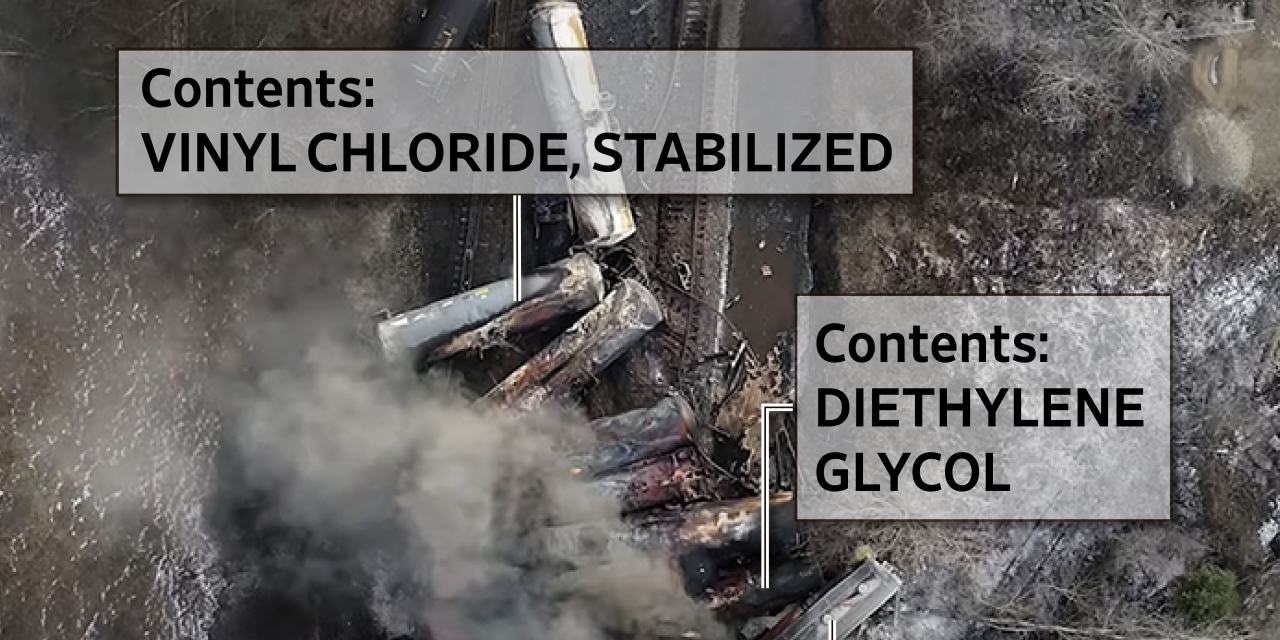Toxic Chemicals From Ohio Train Derailment: Prolonged Presence In Buildings

Table of Contents
Pathways of Chemical Intrusion into Buildings
The toxic chemicals released from the Ohio train derailment can infiltrate buildings through various pathways, leading to prolonged contamination and posing significant health risks. Understanding these pathways is critical for effective mitigation efforts.
Airborne Contamination
Volatile organic compounds (VOCs), such as vinyl chloride and butyl acrylate, are particularly concerning due to their ability to remain airborne and penetrate building materials. These chemicals can adsorb onto surfaces, slowly releasing into the indoor air over extended periods. Furthermore, they can become trapped within porous materials like drywall and insulation, leading to a persistent source of indoor air pollution. Bioaccumulation in dust further complicates the issue, creating a reservoir of contaminants that can be re-suspended into the air through everyday activities.
- Adsorption onto surfaces: Chemicals adhere to surfaces, slowly releasing into the air.
- Slow release from porous materials: Chemicals trapped in building materials can leach out over time.
- Potential for bioaccumulation in dust: Dust particles can act as carriers and reservoirs for these chemicals.
Water Contamination
Groundwater and surface water contamination resulting from the derailment pose another significant threat. Contaminated water can infiltrate building plumbing systems, potentially leading to contaminated drinking water and impacting other water sources within the building. Leaching from contaminated soil into building foundations can further exacerbate this problem.
- Well water contamination: Private wells are particularly vulnerable to contamination from leaked chemicals.
- Surface runoff impacting basements: Runoff from contaminated areas can seep into basements through cracks and gaps.
- Potential for contamination of indoor water supplies: Contaminated water can enter buildings through plumbing systems.
Soil Contamination
Contaminated soil presents a direct pathway for chemical intrusion into buildings. Vapor intrusion, where volatile chemicals from contaminated soil migrate into buildings through cracks and gaps in the foundation, is a significant concern. This can lead to elevated levels of toxic chemicals in basement air and crawl spaces.
- Soil-gas intrusion through cracks and gaps: Chemicals can migrate from contaminated soil into building interiors.
- Impact on basement air quality: Elevated levels of VOCs in basements can pose serious health risks.
- Potential for contamination of crawl spaces: Crawl spaces can act as pathways for chemical migration into living spaces.
Health Risks Associated with Prolonged Exposure
Prolonged exposure to the toxic chemicals released from the Ohio train derailment poses serious health risks, both in the short and long term. The severity of these effects can vary depending on factors such as the level and duration of exposure, individual susceptibility, and the specific chemical involved.
Short-Term Health Effects
Exposure to chemicals like vinyl chloride and butyl acrylate can lead to a range of immediate health problems. These can include respiratory irritation, nausea, headaches, and dizziness. Children, the elderly, and individuals with pre-existing respiratory or cardiovascular conditions are particularly vulnerable to these short-term effects.
- Irritation of eyes, nose, and throat: Common symptoms of exposure to VOCs.
- Respiratory problems: Wheezing, coughing, and shortness of breath can occur.
- Neurological symptoms: Headaches, dizziness, and confusion are possible.
Long-Term Health Effects
The long-term health consequences of exposure to these toxic chemicals are a significant concern. Studies have linked exposure to vinyl chloride to an increased risk of liver cancer, and butyl acrylate is associated with respiratory problems and potential reproductive issues. The lack of comprehensive long-term studies makes it challenging to fully understand the potential future health impacts on affected communities.
- Increased risk of certain cancers: Exposure to some of these chemicals is linked to various cancers.
- Chronic respiratory diseases: Long-term respiratory problems can develop following exposure.
- Developmental issues in children: Exposure during pregnancy or early childhood can lead to developmental problems.
Remediation and Mitigation Strategies
Addressing the contamination from the Ohio train derailment requires a multi-faceted approach focused on air, water, and soil remediation. Early intervention is crucial to minimize the long-term health impacts.
Air Quality Testing and Remediation
Professional air quality testing is crucial to assess the extent of airborne contamination within affected buildings. Remediation strategies may include installing high-efficiency particulate air (HEPA) filters, improving ventilation systems, and implementing other air purification techniques.
- Professional air sampling and analysis: Accurately determine the levels of contaminants in the air.
- Installation of high-efficiency particulate air (HEPA) filters: Remove airborne particles and chemicals.
- Increased ventilation rates: Improve air exchange to dilute indoor air contaminants.
Water Testing and Remediation
Testing drinking water and other water sources within buildings is essential to identify any contamination. Remediation strategies may involve installing water filters, replacing contaminated water sources (such as wells), or connecting to a municipal water supply.
- Water sampling and analysis: Identify the presence and levels of contaminants.
- Installation of water filters: Remove contaminants from drinking water.
- Potential need for well replacement or connection to municipal water supply: May be necessary in cases of severe groundwater contamination.
Soil Remediation
In cases of severe soil contamination, extensive soil remediation may be necessary. This can involve excavation and removal of contaminated soil, followed by replacement with clean fill. Soil vapor extraction may be employed to remove volatile chemicals from the soil. These are complex and costly procedures.
- Soil sampling and analysis: Determine the extent and nature of soil contamination.
- Excavation and removal of contaminated soil: May be necessary in severely contaminated areas.
- Soil vapor extraction: Remove volatile chemicals from the soil using vacuum systems.
Conclusion
The lingering presence of toxic chemicals from the Ohio train derailment in buildings poses a significant threat to public health and safety. Understanding the pathways of contamination, associated health risks, and available remediation strategies is crucial for protecting residents. Prompt action, including comprehensive testing and remediation efforts, is essential to mitigate the long-term impact of these toxic chemicals and ensure the safety of individuals residing in affected areas. If you suspect your building may be affected by the Ohio train derailment's toxic chemicals, seek professional assessment and remediation immediately. Don't delay – act now to protect yourself and your family from the lingering effects of these dangerous substances.

Featured Posts
-
 Snls Marcello Hernandez A Suitcase Full Of Laughs Dog Included
May 18, 2025
Snls Marcello Hernandez A Suitcase Full Of Laughs Dog Included
May 18, 2025 -
 Michelle Williams Clarifies Dying For Sex Scene With Marcello Hernandez
May 18, 2025
Michelle Williams Clarifies Dying For Sex Scene With Marcello Hernandez
May 18, 2025 -
 The Often Overlooked Value Of Middle Managers In Modern Businesses
May 18, 2025
The Often Overlooked Value Of Middle Managers In Modern Businesses
May 18, 2025 -
 Details Emerge Angels Stars Family Faces Health Challenges This Offseason
May 18, 2025
Details Emerge Angels Stars Family Faces Health Challenges This Offseason
May 18, 2025 -
 Reddits New Policy Cracking Down On Violent Content Upvotes
May 18, 2025
Reddits New Policy Cracking Down On Violent Content Upvotes
May 18, 2025
Latest Posts
-
 Jersey Mikes Subs Galesburg Grand Opening
May 18, 2025
Jersey Mikes Subs Galesburg Grand Opening
May 18, 2025 -
 New Jersey Mikes Subs Location Opens In Galesburg
May 18, 2025
New Jersey Mikes Subs Location Opens In Galesburg
May 18, 2025 -
 Galesburg Welcomes Jersey Mikes Subs
May 18, 2025
Galesburg Welcomes Jersey Mikes Subs
May 18, 2025 -
 Post 2025 Nfl Draft Analysts Take On The New England Patriots
May 18, 2025
Post 2025 Nfl Draft Analysts Take On The New England Patriots
May 18, 2025 -
 Patriots Future Nfl Analyst Weighs In On Post 2025 Draft Outlook
May 18, 2025
Patriots Future Nfl Analyst Weighs In On Post 2025 Draft Outlook
May 18, 2025
